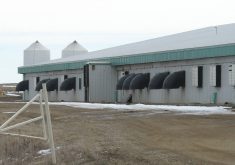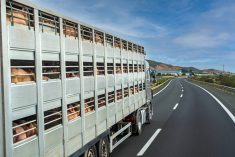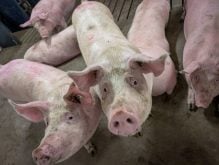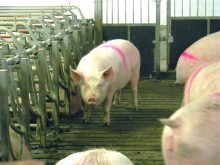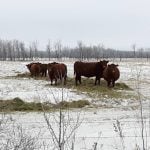Winter has given the hog sector a different challenge in its fight with porcine epidemic diarrhea (PED).
Jenelle Hamblin, manager of swine health programs with the Manitoba Pork Council (MPC), said the outbreak is trending similarly to 2017 and 2019, both record-breaking years, albeit with a three-week lag in case counts.
Now 12 weeks into the outbreak, Manitoba counted 54 cases as of Jan. 13.
Most cases as of Jan. 12 were contained to southeastern Manitoba, according to Hamblin — the historic hot spot for the disease — although two cases near Brunkild were reported early in the outbreak, as well as one more recent case in the RM of Cartier and another in the RM of North Norfolk.
Read Also

Beekeepers want financial protection against tropi mite
What happens to beekeepers if the deadly tropi mite reaches Canada? Discover why farmers want robust compensation to protect pollination.
“Another marked difference in this outbreak is we can see a relatively clear designation of when certain areas of the province broke,” she said.
There have been clear linkages between case spikes and particular regions, she said, unlike prior years.
Why it matters: Porcine epidemic diarrhea (PED) has been back with a vengeance since late October. The virus is infamous for mortality rates in piglets under 14 days old.
Dr. Glen Duizer of the province’s Chief Veterinary Office (CVO) estimates 65,000 to 70,000 sows are currently affected by the virus. That range is based on a facility’s max capacity, he added, accounting for the large spread.
“It is a neonatal pig disease… so those sow farms represent the real severe impact to the industry,” he said.
It is the third major PED outbreak in Manitoba since 2017. That year, cases ballooned to 80 positive premises, followed two years later in 2019 when 82 cases were reported.
Experts like Duizer now suggest that the virus follows a two-year cycle between major outbreaks — something that may be linked to waning herd immunity, although no concrete reason has been determined.
Late start
While the timing may have been right for a bad PED year in 2021, the timing of this outbreak is new.
Cases in both 2017 and 2019 peaked in summer. In 2021, however, there had been an absolute lack of new PED cases until well into fall. Hopes for a PED-free year were dashed in late October, however, with a single confirmed case. Numbers bloomed over the following weeks, eventually leading the Manitoba Pork Council and CVO to announce that Manitoba was once again dealing with an outbreak.
Change in the weather
There has been little change in the actual list of PED risk factors, despite the different timing, both Duizer and Hamblin said.
Animal movement, biosecurity breaches, breaches in transport biosecurity, area spread and high-traffic facilities have all been in play in the current outbreak, much like previous years. In a handful of cases, Duizer said, the virus likely hitched a ride on airborne particles like dust.
Winter, however, has brought complications, and risk factors that were less significant in warm weather are taking a more central focus.
Disinfecting contact points at high-traffic sites, for example, becomes much more difficult at -30 C, Duizer noted. There is stress on equipment and transport, he said, while managing biosecurity in the farmyard is harder, as is cleaning load-out areas.
“All of those factors and the biosecurity and cleaning and disinfection protocols, all of those, we see impacted by this cold weather condition,” he said.
At the same time, winter cases have meant little risk from manure application or field work, which did play into previous outbreaks.
The highly integrated nature of the hog industry, meanwhile, means a large number of common touch points for the virus to spread through, Hamblin noted.
“Whether it be through our high-traffic facilities, our assembly yards, our abattoirs, there are crossovers and linkages and we need to take our best due diligence when we are visiting those places, as well as when we are on their farms,” she said.
The pork council’s high-traffic site surveillance program — which tests for PED at places like Manitoba’s federally certified slaughter plants and other high-risk sites — has reported regular positive PED tests, Hamblin said.
COVID-19
The ongoing human disease concern is adding yet another challenge as barn staff fall ill with COVID-19.
The industry has moved away from sharing staff between sites in order to reduce the risk of spreading diseases like PED between premises. But while the policy is good biosecurity, it also reduces some labour flexibility should a significant part of the workforce get ill.
It’s possible that producers may be forced to take on that extra biosecurity risk if there is insufficient staff to properly care for the pigs, according to Duizer. To date, however, it has not been a factor in 2021-22.
Adapting for winter
Overall biosecurity principles have not changed with the winter season, according to Hamblin. How they’re applied, however, may have seen some shift.
“We’ve seen an uptick in the amount of baking that’s happening for our trailers, perhaps more than normal,” she said. “The cold weather has fought us on that one as well, with mechanical issues and what have you.”
Bill Rempel of Steve’s Livestock Transport is well familiar with those challenges.
There has been a transportation slowdown in the province, he said, driven partly by the extreme cold, as well as a double hit of issues in the wash bay.
“The spread of PED certainly puts a demand on increased biosecurity, so there’s more washes. There’s more drying of trailers,” he said. “On top of that, we’ve also had some disruption of staffing in our wash facilities who have got sick and have been off for periods of time.”
MPC is urging the hog sector in general to take its biosecurity game up a level.
The disease has proven unforgiving to even the slightest biosecurity breach, Hamblin said.
The organization also continues to urge producers to sign on with the Manitoba Coordinated Disease Response, a program launched in the wake of the 2017 PED outbreak which quickly distributes updates, risk information and resources to producers.




